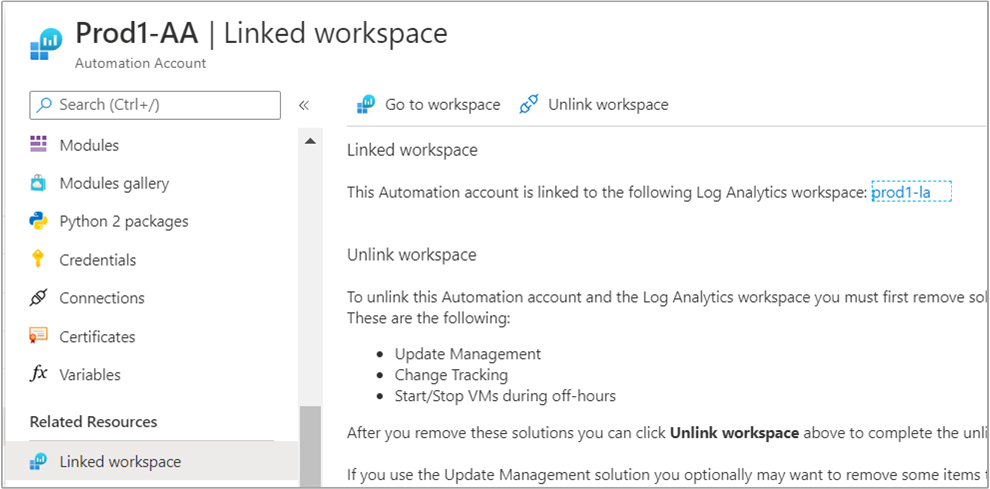你当前正在访问 Microsoft Azure Global Edition 技术文档网站。 如果需要访问由世纪互联运营的 Microsoft Azure 中国技术文档网站,请访问 https://docs.azure.cn。
使用资源管理器模板创建 Azure 自动化帐户
Azure 自动化提供基于云的自动化和配置服务,用于支持 Azure 环境和非 Azure 环境之间的一致管理。 本文介绍如何部署用于创建自动化帐户的 Azure 资源管理器模板(ARM 模板)。 与其他部署方法相比,使用 ARM 模板需要的步骤更少。 JSON 模板可为参数指定默认值,这些参数可能用作环境中的标准配置。 可以将模板存储在 Azure 存储帐户中,以便在组织中共享访问。 有关使用模板的详细信息,请参阅使用 ARM 模板和 Azure CLI 部署资源。
Azure 资源管理器模板是定义项目基础结构和配置的 JavaScript 对象表示法 (JSON) 文件。 模板使用声明性语法。 你可以在不编写用于创建部署的编程命令序列的情况下,描述预期部署。
此示例模板执行以下步骤:
- 自动创建 Azure Monitor Log Analytics 工作区。
- 自动创建 Azure 自动化帐户。
- 将自动化帐户链接到 Log Analytics 工作区。
- 将示例自动化 runbook 添加到帐户。
如果没有 Azure 订阅,请在开始之前创建一个免费帐户。
先决条件
如果你不熟悉 Azure 自动化和 Azure Monitor,请务必了解配置详细信息。 当你尝试创建、配置和使用链接到新自动化帐户的 Log Analytics 工作区时,该了解有助于避免出错。
查看其他详细信息以充分了解工作区配置选项,如访问控制模式、定价层、保留期和产能预留级别。
查看工作区映射,以内联方式或在参数文件中指定支持的区域。 只有某些区域支持链接订阅中的 Log Analytics 工作区和自动化帐户。
如果刚开始使用 Azure Monitor 日志,并且尚未部署工作区,则查看工作区设计指南。 此文档将有助于了解访问控制,以及帮助了解适用于组织的建议设计实现策略。
查看模板
本文中使用的模板来自 Azure 快速入门模板。
{
"$schema": "https://schema.management.azure.com/schemas/2019-04-01/deploymentTemplate.json#",
"contentVersion": "1.0.0.0",
"parameters": {
"workspaceName": {
"type": "string",
"metadata": {
"description": "Workspace name"
}
},
"sku": {
"type": "string",
"defaultValue": "pergb2018",
"allowedValues": [
"pergb2018",
"Free",
"Standalone",
"PerNode",
"Standard",
"Premium"
],
"metadata": {
"description": "Pricing tier: perGB2018 or legacy tiers (Free, Standalone, PerNode, Standard or Premium), which are not available to all customers."
}
},
"dataRetention": {
"type": "int",
"defaultValue": 30,
"minValue": 7,
"maxValue": 730,
"metadata": {
"description": "Number of days to retain data."
}
},
"location": {
"type": "string",
"defaultValue": "[resourceGroup().location]",
"metadata": {
"description": "Specifies the location in which to create the workspace."
}
},
"automationAccountName": {
"type": "string",
"metadata": {
"description": "Automation account name"
}
},
"sampleGraphicalRunbookName": {
"type": "String",
"defaultValue": "AzureAutomationTutorial"
},
"sampleGraphicalRunbookDescription": {
"type": "String",
"defaultValue": "An example runbook that gets all the Resource Manager resources by using the Run As account (service principal)."
},
"samplePowerShellRunbookName": {
"type": "String",
"defaultValue": "AzureAutomationTutorialScript"
},
"samplePowerShellRunbookDescription": {
"type": "String",
"defaultValue": "An example runbook that gets all the Resource Manager resources by using the Run As account (service principal)."
},
"samplePython2RunbookName": {
"type": "String",
"defaultValue": "AzureAutomationTutorialPython2"
},
"samplePython2RunbookDescription": {
"type": "String",
"defaultValue": "An example runbook that gets all the Resource Manager resources by using the Run As account (service principal)."
},
"_artifactsLocation": {
"type": "string",
"defaultValue": "[deployment().properties.templateLink.uri]",
"metadata": {
"description": "URI to artifacts location"
}
},
"_artifactsLocationSasToken": {
"type": "securestring",
"defaultValue": "",
"metadata": {
"description": "The sasToken required to access _artifactsLocation. When the template is deployed using the accompanying scripts, a sasToken will be automatically generated"
}
}
},
"resources": [
{
"type": "Microsoft.OperationalInsights/workspaces",
"apiVersion": "2020-08-01",
"name": "[parameters('workspaceName')]",
"location": "[parameters('location')]",
"properties": {
"sku": {
"name": "[parameters('sku')]"
},
"retentionInDays": "[parameters('dataRetention')]",
"features": {
"searchVersion": 1,
"legacy": 0
}
}
},
{
"type": "Microsoft.Automation/automationAccounts",
"apiVersion": "2020-01-13-preview",
"name": "[parameters('automationAccountName')]",
"location": "[parameters('location')]",
"dependsOn": [
"[parameters('workspaceName')]"
],
"identity": {
"type": "SystemAssigned"
},
"properties": {
"sku": {
"name": "Basic"
}
},
"resources": [
{
"type": "runbooks",
"apiVersion": "2020-01-13-preview",
"name": "[parameters('sampleGraphicalRunbookName')]",
"location": "[parameters('location')]",
"dependsOn": [
"[parameters('automationAccountName')]"
],
"properties": {
"runbookType": "GraphPowerShell",
"logProgress": "false",
"logVerbose": "false",
"description": "[parameters('sampleGraphicalRunbookDescription')]",
"publishContentLink": {
"uri": "[uri(parameters('_artifactsLocation'), concat('scripts/AzureAutomationTutorial.graphrunbook', parameters('_artifactsLocationSasToken')))]",
"version": "1.0.0.0"
}
}
},
{
"type": "runbooks",
"apiVersion": "2020-01-13-preview",
"name": "[parameters('samplePowerShellRunbookName')]",
"location": "[parameters('location')]",
"dependsOn": [
"[parameters('automationAccountName')]"
],
"properties": {
"runbookType": "PowerShell",
"logProgress": "false",
"logVerbose": "false",
"description": "[parameters('samplePowerShellRunbookDescription')]",
"publishContentLink": {
"uri": "[uri(parameters('_artifactsLocation'), concat('scripts/AzureAutomationTutorial.ps1', parameters('_artifactsLocationSasToken')))]",
"version": "1.0.0.0"
}
}
},
{
"type": "runbooks",
"apiVersion": "2020-01-13-preview",
"name": "[parameters('samplePython2RunbookName')]",
"location": "[parameters('location')]",
"dependsOn": [
"[parameters('automationAccountName')]"
],
"properties": {
"runbookType": "Python2",
"logProgress": "false",
"logVerbose": "false",
"description": "[parameters('samplePython2RunbookDescription')]",
"publishContentLink": {
"uri": "[uri(parameters('_artifactsLocation'), concat('scripts/AzureAutomationTutorialPython2.py', parameters('_artifactsLocationSasToken')))]",
"version": "1.0.0.0"
}
}
}
]
},
{
"type": "Microsoft.OperationalInsights/workspaces/linkedServices",
"apiVersion": "2020-08-01",
"name": "[concat(parameters('workspaceName'), '/' , 'Automation')]",
"location": "[parameters('location')]",
"dependsOn": [
"[parameters('workspaceName')]",
"[parameters('automationAccountName')]"
],
"properties": {
"resourceId": "[resourceId('Microsoft.Automation/automationAccounts', parameters('automationAccountName'))]"
}
}
]
}
该模板中定义的 Azure 资源:
- Microsoft.OperationalInsights/workspaces:创建 Azure Log Analytics 工作区。
- Microsoft.Automation/automationAccounts:创建 Azure 自动化帐户。
- Microsoft.Automation/automationAccounts/runbooks:创建 Azure 自动化帐户 Runbook。
部署模板
选择下面的“部署到 Azure”按钮登录到 Azure,并打开 ARM 模板。
输入或选择下列值:
属性 说明 订阅 从下拉列表中选择自己的 Azure 订阅。 资源组 从下拉列表中选择现有资源组,或选择“新建” 。 区域 此值将自动填充。 工作区名称 输入新 Log Analytics 工作区的名称。 SKU 默认为“按 GB”定价层,该层已在 2018 年 4 月的定价模型中发布。 如果要在订阅中创建或配置 Log Analytics 工作区,而该订阅已加入 2018 年 4 月的定价模型,则唯一有效的 Log Analytics 定价层为 PerGB2018。数据保留 默认为 30 天。 位置 将使用用于资源组的位置自动填充此值。 自动化帐户名称 输入新自动化帐户的名称。 示例图形 Runbook 名称 原样保留。 示例图形 Runbook 说明 原样保留。 示例 PowerShell Runbook 名称 原样保留。 示例 PowerShell Runbook 说明 原样保留。 示例 Python2Runbook 名称 原样保留。 示例 Python2Runbook 说明 原样保留。 _artifacts 位置 原样保留。* 项目位置的 URI。 _artifacts 位置 SAS 令牌 留空。 访问 _artifactsLocation所需的 sasToken。 使用随附的脚本部署模板时,将自动生成sasToken。* 尝试从门户中的 PowerShell、CLI 或模板功能运行 ARM 模板时,如果未正确设置
_artifactsLocation参数,你将会收到类似以下的错误消息:"message": "Deployment template validation failed: 'The template resource '_artifactsLocation' at line '96' and column '31' is not valid: The language expression property 'templateLink' doesn't exist, available properties are 'template, templateHash, parameters, mode, debugSetting, provisioningState'.. Please see https://aka.ms/arm-template-expressions for usage details.'."若要防止此错误,从门户中的模板功能运行时,为
_artifactsLocation参数指定以下值 -https://raw.githubusercontent.com/Azure/azure-quickstart-templates/master/quickstarts/microsoft.automation/101-automation/azuredeploy.json。从 PowerShell 运行时,请包含参数且其值为
-TemplateUri https://raw.githubusercontent.com/Azure/azure-quickstart-templates/master/quickstarts/microsoft.automation/101-automation/azuredeploy.json。从 Azure CLI 运行时,请包含参数且其值为
--template-uri https://raw.githubusercontent.com/Azure/azure-quickstart-templates/master/quickstarts/microsoft.automation/101-automation/azuredeploy.json。有关 PowerShell/CLI 的参考,请参阅“使用模板”部分下的创建 Azure 自动化帐户 (microsoft.com)。
选择“审阅 + 创建”,然后选择“创建” 。 部署可能需要几分钟才能完成。 完成后,输出类似于以下图像:

查看已部署的资源
部署完成后,你会收到“部署成功”通知,通知中附有“转到资源”链接 。 “资源组”页面将列出你的新资源。 从列表中选择新的自动化帐户。
从左侧的“过程自动化”下,选择“Runbook”。 “Runbook”页列出了使用自动化帐户创建的三个示例 Runbook。

从左侧的“相关资源”下,选择“链接的工作区” 。 “链接的工作区”页显示了先前指定的、已链接到自动化帐户的 Log Analytics 工作区。

后续步骤
为自动化帐户配置诊断设置,以将 runbook 作业状态和作业流发送到链接的 Log Analytics 工作区。
